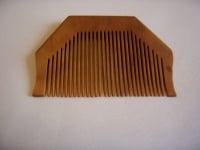Kanga: Difference between revisions
Hari singh (talk | contribs) No edit summary |
Hari singh (talk | contribs) No edit summary |
||
| Line 1: | Line 1: | ||
The [[Sikh]]s were commanded by [[Guru Gobind Singh]] to wear a '''small comb''' called a [[Kanga]] at all times. This was to | [[Image:CIMG0336.JPG|thumb|200px|right|Kanga - one of the five articles of faith for the Sikhs]] | ||
The [[Sikh]]s were commanded by [[Guru Gobind Singh]] at the [[Baisakhi]] [[Amrit Sanchar]] in [[1699]] to wear a '''small comb''' called a [[Kanga]] at all times.This was one of five articles of faith, collectively called [[Kakars]] that form the external visible symbols to clearly and outwardly display ones commitment and dedication to the order ([[Hukam]]) of the tenth master and become a member of [[Khalsa]]. The Khalsa is the "Saint-Soldier" of Guru Gobind Singh who stated the following: | |||
''"He does not recognize anyone else except One Lord, not even the bestowal of charities, performance of merciful acts, austerities and restraint on pilgrim-stations; the '''perfect light of the Lord illuminates his heart, then consider him as the immaculate Khalsa'''."'' (Guru Gobind Singh in the Dasam Granth page 1350) | |||
The Kanga is an article that allows the Sikh to care for he or her unshorn long hair, [[Kesh]]. The kanga is usually tucked behind the "Rishi Knot" and tied under the turban. It is to be used twice daily to comb and keep the hair in a disentangled and tidy condition. It represents the importance of discipline and cleanliness to a Sikh way of life and is used to keep the hair healthy, clean, shining and tangle-free. The [[Kanga]] is tucked under the rishi knot to keep the rishi knot firm and in place. | |||
Revision as of 05:20, 19 June 2006
The Sikhs were commanded by Guru Gobind Singh at the Baisakhi Amrit Sanchar in 1699 to wear a small comb called a Kanga at all times.This was one of five articles of faith, collectively called Kakars that form the external visible symbols to clearly and outwardly display ones commitment and dedication to the order (Hukam) of the tenth master and become a member of Khalsa. The Khalsa is the "Saint-Soldier" of Guru Gobind Singh who stated the following: "He does not recognize anyone else except One Lord, not even the bestowal of charities, performance of merciful acts, austerities and restraint on pilgrim-stations; the perfect light of the Lord illuminates his heart, then consider him as the immaculate Khalsa." (Guru Gobind Singh in the Dasam Granth page 1350)
The Kanga is an article that allows the Sikh to care for he or her unshorn long hair, Kesh. The kanga is usually tucked behind the "Rishi Knot" and tied under the turban. It is to be used twice daily to comb and keep the hair in a disentangled and tidy condition. It represents the importance of discipline and cleanliness to a Sikh way of life and is used to keep the hair healthy, clean, shining and tangle-free. The Kanga is tucked under the rishi knot to keep the rishi knot firm and in place.
| These articles deal with Sikh's Five ks |
|
Kesh (uncut hair) -|- Kara (bangle) -|- Kanga (small comb) -|- Kachera (under garment) -|- Kirpan (sword) |

